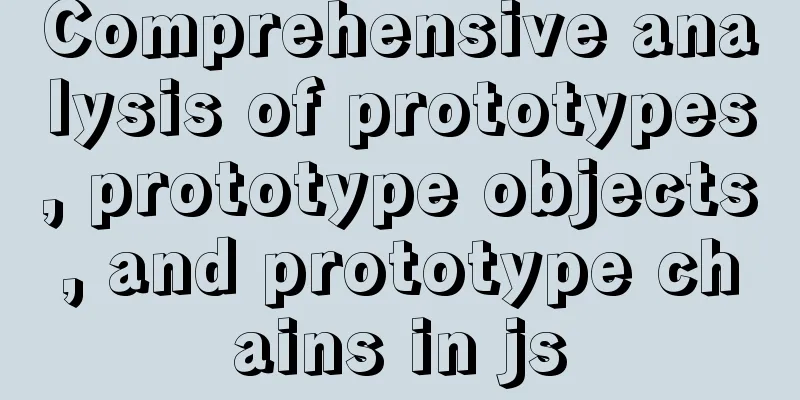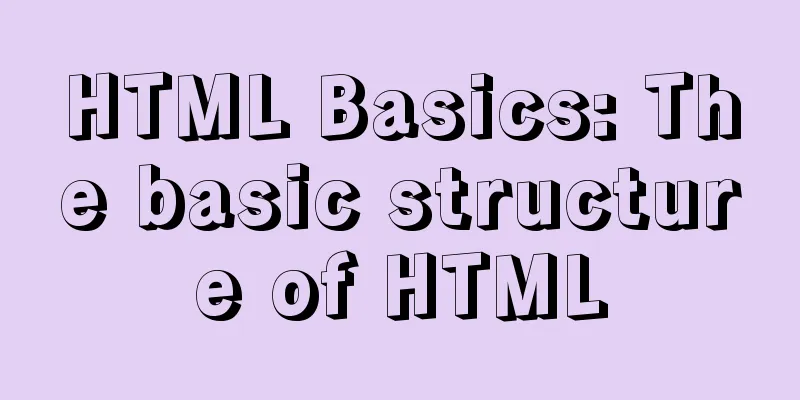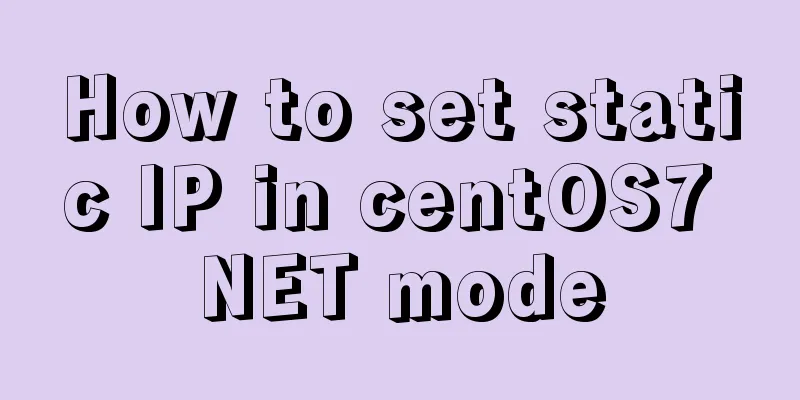Comprehensive analysis of prototypes, prototype objects, and prototype chains in js

Understanding PrototypesEvery function we create has a prototype property, which is a pointer to an object whose purpose is to contain properties and methods that can be shared by all instances of a particular type. Consider the following example:
function Person(){
}
Person.prototype.name = 'ccc'
Person.prototype.age = 18
Person.prototype.sayName = function (){
console.log(this.name);
}
var person1 = new Person()
person1.sayName() // --> ccc
var person2 = new Person()
person2.sayName() // --> ccc
console.log(person1.sayName === person2.sayName) // --> true Understanding Prototype ObjectsAccording to the above code, see the following figure:
Three points need to be understood:
Note: There is no direct relationship between the person1 and person2 instances and the constructor. As we mentioned before, [[prototype]] is not accessible in all implementations, so how do we know if there is a relationship between the instance and the prototype object? There are two ways to judge here:
Relationship between instance properties and prototype propertiesWe mentioned earlier that the prototype initially contains only the constructor property, which is also shared and therefore accessible through the object instance. Although you can access the values stored in the prototype through an object instance, you cannot overwrite the values in the prototype through an object instance. If we add a property to an instance and the property has the same name as a property in the instance prototype, then the property will be created on the instance and the property in the prototype will be masked. as follows:
function Person() {}
Person.prototype.name = "ccc";
Person.prototype.age = 18;
Person.prototype.sayName = function() {
console.log(this.name);
};
var person1 = new Person();
var person2 = new Person();
person1.name = 'www' // Add a name attribute to person1 person1.sayName() // --> 'www'————'From the instance'
person2.sayName() // --> 'ccc'————'from prototype'
console.log(person1.hasOwnProperty('name')) // --> true
console.log(person2.hasOwnProperty('name')) // --> false
delete person1.name // --> Delete the newly added name attribute in person1 person1.sayName() // -->'ccc'————'from prototype'How do we determine whether a property is an instance property or a prototype property? Here you can use the hasOwnProperty() method to detect whether a property exists in the instance or in the prototype. (This method is inherited from Object) The following figure analyzes in detail the relationship between the implementation and prototype of the above example in different situations: (the relationship of the Person constructor is omitted)
Simpler prototype syntaxWe can't always type Person.prototype every time we add a property and method, as in the previous example. To reduce unnecessary typing, a more common approach is as follows:
function Person(){}
Person.prototype = {
name: 'ccc',
age: 18,
sayName: function () {
console.log(this.name)
}
}In the code above, we set Person.prototype equal to a new object created as an object literal. The end result is the same, with one exception: the constructor property no longer points to Person. As we mentioned earlier, every time a function is created, its prototype object is created at the same time, and this object automatically acquires the constructor property. But in the new syntax we use, the default prototype object is essentially completely rewritten, so the constructor property becomes the constructor property of the new object (pointing to the Object constructor), and no longer points to the Person function. At this point, although the instanceof operator can still return the correct result, the type of the object can no longer be determined through the constructor. as follows: var person1 = new Person() console.log(person1 instanceof Object) // --> true console.log(person1 instanceof Person) // --> true console.log(person1.constructor === Person) // --> false console.log(person1.constructor === Object) // --> true Here, the instanceof operator is used to test Object and Person and still returns true. The constructor property is equal to Object, not Person. If the constructor is really important, you can write it like this:
function Person(){}
Person.prototype = {
constructor: Person, // --> reset name: 'ccc',
age: 18,
sayName: function () {
console.log(this.name)
}
}However, this will cause a new problem. Resetting the constructor property in the above way will cause its [[Enumerable]] attribute to be set to true. By default, native constructor properties are not enumerable. So if you want to use an ECMAscript5-compatible JavaScript engine, you can try Object.defineProperty().
function Person(){}
Person.constructor = {
name: 'ccc',
age: 18,
sayName: function(){
console.log(this.name)
}
}
// Reset the constructor, only applicable to ECMAscript5 compatible browsers Object.defineProperty(Person.constructor, "constructor", {
enumerable: false,
value: Person
}) Dynamics of PrototypeSince the process of looking up a value in the prototype is a single search, any changes we make to the prototype object are immediately reflected in the instance. for example:
function Person(){}
var person1 = new Person()
Person.prototype.sayHi = function(){
console.log('hi')
}
person1.sayHi() In the above code, we first create a Person instance and save it in person1, and then add the sayHi() method to Person.prototype. Even though person1 was created before the new method was added, it can still access this method. The reason is the loose connection between instances and prototypes.
function Person(){}
var person1 = new Person()
Person.prototype = {
name: 'ccc',
age: 18,
sayName: function(){
console.log(this.name)
}
}
person1.sayName() // --> errorSee the following figure for analysis:
When the constructor is called, a [[prototype]] pointer to the original prototype is added to the instance, and changing the prototype to another object is equivalent to severing the connection between the constructor and the original prototype. Remember: the pointer in the instance only points to the prototype, not to the constructor. Understanding the prototype chainThe prototype chain is the main method to achieve inheritance. The basic idea is to have one reference type inherit the properties and methods of another reference type. Before understanding the prototype chain, we must first sort out the relationship between the prototype, prototype object, and instance: each constructor has a prototype object, the prototype object contains a pointer to the constructor, and the instance contains an internal pointer to the prototype object. What if we make the prototype object equal to an instance of another type? Obviously, this prototype object will contain a pointer to another prototype. Look at the code first and then the picture:
function SuperType(){
this.property = true
}
SuperType.prototype.getSuperValue = function(){
return this.property
}
function SubType(){
this.subProperty = false
}
// Inherits SuperType
SubType.prototype = new SuperType()
SubType.prototype.getSubValue = function (){
return this.subProperty
}
var instance = new SubType()
console.log(instance.getSuperValue()) // --> trueThe above code defines two types: SuperType and SubType. Each type has one property and one method.
Analyzing the above figure: instance points to the SubType prototype, and the SubType prototype points to the SuperType prototype. The getSuperValue() method is still in SuperType.prototype, but the property is in SubType.prototype. This is because property is an instance attribute, while getSuperValue() is a prototype method. Since SubType.prototype is now an instance of SuperType, the property is of course located in that instance. Also note that instance.constructor now points to SuperType, because the original constructor in SubType.prototype has been rewritten. Search for instances Search for SubType.prototype Don't forget the default prototype You should know that all reference types inherit Object by default, and this inheritance is also implemented through the prototype chain. The default prototype of all functions is an instance of Object, so the default prototype contains an internal pointer pointing to Object.prototype, which is why all custom types have toString() and valueOf() methods. So the complete prototype chain should be as follows:
Detailed diagram:
In a word, SubType inherits SuperType, and SuperType inherits Object. When calling instant.toString(), the method actually called is the method stored in Object.prototype. Determine the relationship between prototypes and instancesWhen a prototype chain is very long, there are two ways to determine the relationship between the prototype and the instance: Use the instanceof operator. As long as you use this operator to test the instance and the constructor that appears in the prototype chain, the result will return true. console.log(instance instanceof Object) // --> true console.log(instance instanceof SuperType) // --> true console.log(instance instanceof SubType) // --> true Use the isPrototypeOf() method, which is similar to the instantof judgment method. As long as the prototype appears in the prototype chain, it will return true. console.log(Object.prototype.isPrototypeOf(instance)) // --> true console.log(SuperType.prototype.isPrototypeOf(instance)) // --> true console.log(SubType.prototype.isPrototypeOf(instance)) // --> true Define methods carefullyA subtype sometimes needs to override a method in a supertype, or needs to add a method that does not exist in the supertype. But in any case, the code to add methods to the prototype must be placed after the statement that replaces the prototype. as follows:
function SuperType(){
this.property = true;
}
SuperType.prototype.getSuperValue = function(){
return this.property
}
function SubType(){
this.subProperty = false;
}
// Inherits SuperType
SubType.prototype = new SuperType()
// Add new method SubType.prototype.getSubValue = function(){
return this.subProperty
}
// Override the method in the super type SubType.prototype.getSuperValue = function(){
return false
}
var instance = new SubType()
console.log(instance.getSuperValue()) // --> false
var instanceSuper = new SuperType()
console.log(instanceSuper.getSuperValue()) // -> trueIn the above code, the first method getSubValue() is added to SubType. The second method, getSuperValue(), is a method that already exists in the prototype chain, but overriding this method will mask the original method. That is, when getSuperValue() is called through an instance of SubType, the redefined method is called, but when getSuperValue() is called through an instance of SuperType, the original method will continue to be called. Another point is that when inheritance is implemented through the prototype chain, you cannot use object variables to create prototype methods, because this will rewrite the prototype chain and cause the prototype chain to be cut off. The problem with the prototype chainWhen inheritance is implemented through prototypes, the prototype actually becomes an instance of another type, so the original instance properties become the current prototype properties, which causes the properties to be shared. Look at the following code:
function SuperType(){
this.colors = ['white', 'blue']
}
function SubType(){
}
// Inherits SuperType
SubType.prototype = new SuperType()
var instance1 = new SubType()
instance1.colors.push('red')
var instance2 = new SubType()
console.log(instance1.colors) // -->["white", "blue", "red"]
console.log(instance2.colors) // -->["white", "blue", "red"]When creating an instance of a subtype, you cannot pass parameters to the supertype's constructor. In fact, there should be no way to pass parameters to the supertype constructor without affecting all object instances. Therefore, in practice the prototype chain is rarely used alone. The above is the detailed content of the diagram of prototype, prototype object, and prototype chain in js. For more information about prototype, prototype object, and prototype chain in js, please pay attention to other related articles on 123WORDPRESS.COM! You may also be interested in:
|
<<: How to modify port 3389 of Windows server 2008 R2 remote desktop
>>: Solution to the failure of MySQL to use innobackupex to backup the connection server
Recommend
MySQL commonly used SQL and commands from entry to deleting database and running away
Table of contents Start and stop Database related...
How to rename the table in MySQL and what to pay attention to
Table of contents 1. Rename table method 2. Notes...
Vue+SSM realizes the preview effect of picture upload
The current requirement is: there is a file uploa...
Detailed explanation of using Docker to build a development environment for Laravel and Vue projects
This article introduces the development environme...
Steps to modify the MySQL database data file path under Linux
After installing the MySQL database using the rpm...
MySQL 5.7.15 installation and configuration method graphic tutorial (windows)
Because I need to install MySQL, I record the ins...
A brief understanding of the three principles of adding MySQL indexes
1. The Importance of Indexes Indexes are used to ...
Specific usage of fullpage.js full screen scrolling
1.fullpage.js Download address https://github.com...
Solve the problem of docker images disappearing
1. Mirror images disappear in 50 and 93 [root@h50...
Specific use of GNU Parallel
what is it? GNU Parallel is a shell tool for exec...
Methods and problems encountered in installing mariadb in centos under mysql
Delete the previously installed mariadb 1. Use rp...
JavaScript DOMContentLoaded event case study
DOMContentLoaded Event Literally, it fires after ...
The difference between Readonly and Disabled
To summarize: Readonly is only valid for input (te...
Detailed tutorial on installing the jenkins container in a docker environment
Recommended Docker learning materials: https://ww...
Detailed explanation of mysql scheduled tasks (event events)
1. Brief introduction of the event An event is a ...















